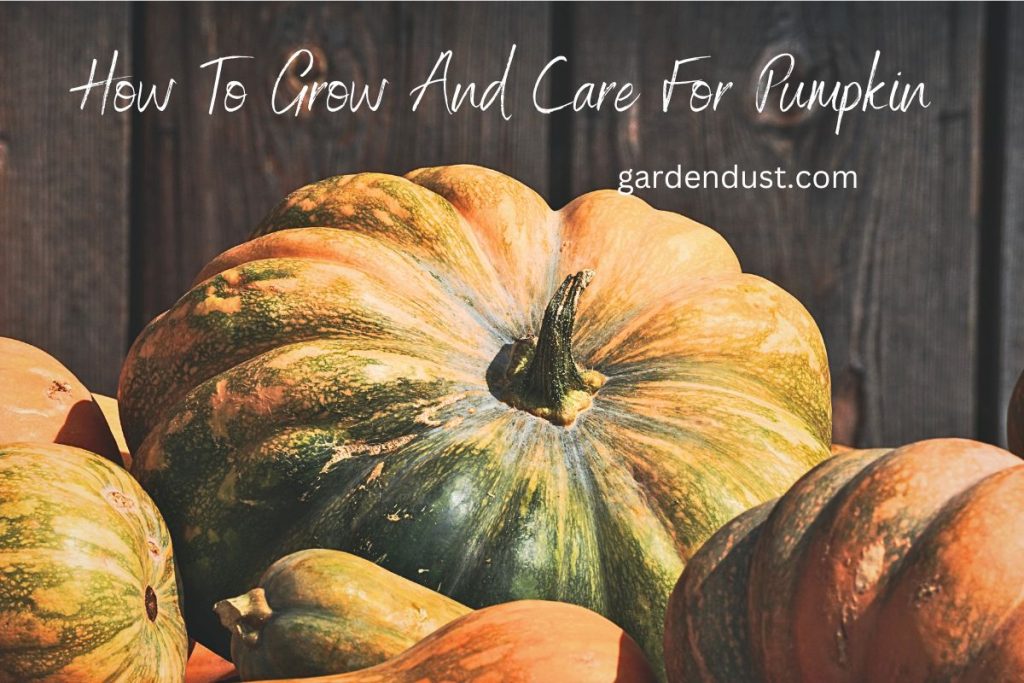Pumpkin is a large, round, orange fruit that belongs to the Cucurbitaceae family. It is native to North America, and widely used in cooking, especially during the fall season in dishes such as pumpkin pie, pumpkin soup, and roasted pumpkin. Pumpkin is also a popular decoration during Halloween, where it is carved into Jack-o’-lanterns with scary faces. Lets start detail about how to grow and care for pumpkin…
A good source of nutrients such as fiber, potassium, vitamin C, and beta-carotene, which is converted into vitamin A in the body. The seeds of the pumpkin are also edible and are a good source of protein, healthy fats, and minerals such as magnesium and zinc.
Apart from its culinary uses, pumpkin is also used in traditional medicine for its anti-inflammatory and antioxidant properties. It is believed to be beneficial for improving vision, reducing the risk of certain cancers, and supporting heart health.
Native– North America
Botanical Name – Cucurbita pepo
Family– Cucurbitaceae
Health Benefits
Pumpkin is a highly nutritious food that offers many health benefits. Some of the potential benefits of consuming pumpkin include:
- Rich in nutrients: Pumpkin is a good source of fiber, potassium, vitamin C, and beta-carotene, which is converted to vitamin A in the body. It also contains smaller amounts of other important vitamins and minerals.
- Supports eye health: The beta-carotene in pumpkin is especially beneficial for eye health, as it helps to prevent age-related macular degeneration and other eye disorders.
- Boosts immunity: Pumpkin is rich in antioxidants, which help to boost the immune system and protect the body against disease.
- Supports heart health: The fiber, potassium, and vitamin C in pumpkin can all contribute to improved heart health, as they help to lower blood pressure, reduce cholesterol levels, and reduce the risk of heart disease.
- May aid in weight loss: Pumpkin is low in calories and high in fiber, which can help to promote feelings of fullness and reduce overall calorie intake.
- Supports digestive health: The fiber in pumpkin can also help to promote digestive health by preventing constipation and promoting the growth of healthy gut bacteria.
- May reduce inflammation: Some studies suggest that the antioxidants in pumpkin may help to reduce inflammation in the body, which is associated with a wide range of health problems.
Overall, adding pumpkin to your diet can be a healthy and delicious way to boost your nutrient intake and support your overall health and well-being.
Grow And Care
If you are growing pumpkin plants, here are some care tips to help them thrive:
- Choose a sunny location:
Pumpkin plants need plenty of sunlight to grow and produce fruit. Choose a location that gets at least six hours of direct sunlight each day.
- Provide fertile soil:
Pumpkins grow best in soil that is rich in organic matter, with a pH between 6.0 and 6.8. Amend the soil with compost or other organic matter before planting.
- Water regularly:
Pumpkin plants need regular watering, especially during hot, dry weather. Water deeply once or twice a week, depending on the weather and soil conditions.
- Fertilize appropriately:
Pumpkin plants benefit from regular fertilization with a balanced, all-purpose fertilizer. Follow the instructions on the fertilizer package for best results.
- Control pests and diseases:
Keep an eye out for common pumpkin pests, such as squash bugs and cucumber beetles, and take steps to control them if necessary. Rotate crops and practice good sanitation to help prevent the spread of diseases.
- Harvest at the right time:
Wait until the pumpkin is fully mature before harvesting. The fruit should have a hard outer rind and a dull, matte appearance. Cut the fruit from the vine with a sharp knife, leaving a few inches of stem attached.
By following these care tips, you can help ensure a bountiful harvest of healthy, delicious pumpkins. Happy Gardening







